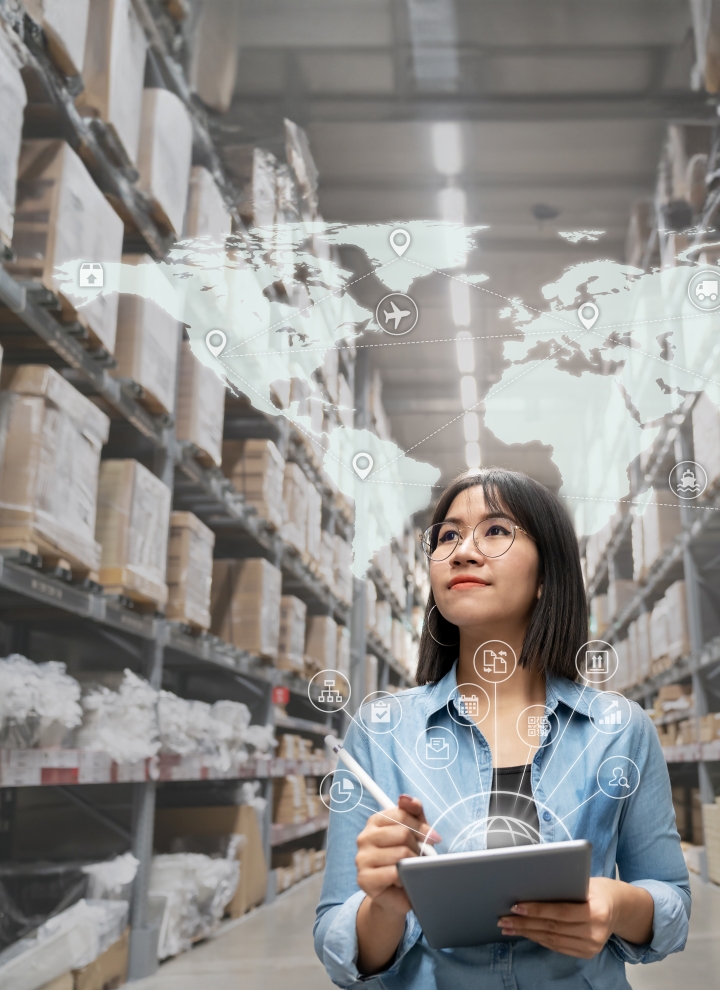Innovation Center Design

Innovation Center Design
Only one out of ten innovation centers deliver on its promise and expectations. With our experience and structured approach, we support building innovation centers that meet or even exceed expectations.
- Definition of success criteria and alignment on strategic goals
- Setup of the innovation center based on critical building blocks (e.g. selection process, funding logic, staffing)
- Successful launch of innovation centers that meet or exceed expectations
- Innovation centers as a top source of innovation
- Clear vision and strategy to drive innovation
- Support of top management
Our industry leaders

Circularity Vehicle Passport

Circularity Vehicle Passport
The automotive industry at the forefront of circularity – a digital transformation
Digital product passports are a core element in the circular economy strategy of the European Union Green Deal.
In the upcoming years, we will see an increasing number of products to be accompanied with digital collections of their individual specifications and characteristics. With this, the EU aims to improve transparency for consumer decisions and all players along the value chain, to promote sustainable products and enable new circular business models.
The greater context – EU Green Deal & the automotive industry
On the path to fight climate change, circularity becomes increasingly prominent within the European Union and its member states. In fact, the European Green Deal declared circularity as one of the main pillars to drive sustainability. This implies that Europe’s major industries need to strive for increasing circular practices within their operations. The automotive industry is set to be one of the key areas for action, claiming the highest resource consumption within the EU as well as relying on an extensive value chain, impacting many other industries. Vehicle production is responsible for 19% of the steel consumption within the EU as well as for 10% of plastics used. Hence, legislators are evaluating measures to drive circular developments within the automotive industry in the context of the European Green Deal. (6)

Siemens Battery Passport
Our colleagues from Siemens are actively developing a Battery Passport ecosystem that goes beyond regulations. It empowers stakeholders to access and manage battery value chain data, using customizable add-on applications for analytics, sustainability, and more. This ecosystem is designed for universal accessibility and seamless integration with existing platforms, ensuring a user-friendly experience along the value chain. Join us in transforming the battery industry.
Several digital product passport approaches are expected to be relevant for the automotive industry. The nearest and most prominent example is the Battery Passport, based on the renewed EU Battery Regulation. It affects all electric vehicles with a high-voltage battery of 2 kWh capacity, sold in the European Union from 2027 onwards.
With a similar timeframe, the Environmental Vehicle Passport is expected, which as measure of the new EU Regulation on Type-Approval of Motor Vehicles (known as Euro 7), will redefine the scope of emission and approval data that carmakers must provide to customers.
Even more important is the Circularity Vehicle Passport, expected for 2032.
The proposal for a regulation on automotive circularity requirements
The Circular Vehicle Passport represents a groundbreaking approach to sustainability, revolutionizing the way we perceive and manage the lifecycle of vehicles. As the automotive industry embraces circular economy principles, the Circularity Vehicle Passport emerges as a pivotal document, enabling the efficient reuse, recycling, and repurposing of vehicles, thereby reducing waste, and minimizing environmental impact. (5)
The proposal by the European Union regarding the regulation on management of end-of-life vehicles, which is currently under evaluation, aims on driving circularity within the automotive industry. It focuses on six key action fields (4):
Design Circular
Improve the rules on how cars must be designed to be easily dismantled for later remanufacturing or material recycling.
Used recycled content
25% of the plastic used to build a new vehicle should be secondary material.
Collect more and smarter
Reduce the number of end-of-life vehicles gone missing, enforce rules for monitoring and increase transparency.
Treat better
Recover more and better-quality raw materials by improving recycling processes and promoting reuse strategies.
Make producers responsible
Stricter governance, improved cooperation, increased circularity.
Cover more vehicles
Gradually extend the scope of the rules, e.g. to commercial vehicles and road bikes (1).
By 2035, the regulation should lead to:
The Circularity Vehicle Passport as the digital enabler
To enforce the regulation and to reach the targets, a Circularity Vehicle Passport is stated as the digital enabler. It serves as a comprehensive, digital record that provides detailed information about a product's design, manufacturing, materials, and environmental impact, facilitating transparency, traceability, and sustainable practices throughout its lifecycle. Following more prominent solutions such as the Battery Passport or the Circularity Vehicle Passport may include:
- Material data, such as the composition of the vehicle, the weight of the materials used and their origin.
- Dismantling information, such as disassembly instructions, and recycling recommendations. (3)
Our take on the Circularity Vehicle Passport
The current regulation is still in its infancy and has not passed the proposal stage yet. Until now, there has been no official timeline set for the implementation of the regulation, neither have detailed information on the contents of the Circularity Vehicle Passport been defined. However, at Siemens Advanta Consulting, we believe that this or similar regulations will certainly become reality in the near future, following the landmarks of the European Green Deal. For the Circularity Vehicle Pass, we expect the corresponding regulation to enter into force in the beginning of the next decade. Therefore, we recommend automotive OEMs to engage in thought leadership and drive the development of an infrastructure which can enable digital product passports. Pioneers will further have the chance to push own standards in the market and actively collaborate on the development of industry standards. We also believe that those who go ahead now, can leverage considerable synergies from existing or planned digital product passports, such as the Battery Passport. Ultimately, just like the latter mentioned, the Circularity Vehicle Passport may also enable internal use cases for manufacturers to save costs, improve quality, or facilitate new business models and customer features.
With deep expertise in supporting external clients in the setup of already existing product passports, Siemens Advanta Consulting is your expert in the fast paced and constantly changing world of digital product passports. We are happy to guide you on your way towards a more sustainable future by using such digital tools, from the initial exploration of a fitting solution for you until the integration of the solution. We look forward to helping you close the loop and stepping into a bright circular future.
Our industry leader

- European Commission - Press release; Circular economy: improving design and end-of-life management of cars for more resource-efficient automotive sector; Brussels, 13 July 2023
- End-of-life vehicles Regulation (europa.eu)
- Proposal for a REGULATION OF THE EUROPEAN PARLIAMENT AND OF THE COUNCIL on circularity requirements for vehicle design and on management of end-of-life vehicles, amending Regulations (EU) 2018/858 and 2019/1020 and repealing Directives 2000/53/EC and 2005/64/EC; (Text with EEA relevance) {SEC(2023) 292 final} - {SWD(2023) 255 final} - {SWD(2023) 256 final} - {SWD(2023) 257 final}; Brussels, 13.07.2023
- COMMISSION STAFF WORKING DOCUMENT; Subsidiarity Grid; Accompanying the document
Proposal for a REGULATION OF THE EUROPEAN PARLIAMENT AND OF THE COUNCIL on circularity requirements for vehicle design and on management of end-of-life vehicles, amending Regulations (EU) 2018/858 and 2019/1020, repealing Directives 2000/53/EC and 2005/64/EC; {COM(2023) 451 final} - {SEC(2023) 292 final} - {SWD(2023) 256 final} - {SWD(2023) 257 final}; Brussels, 13.07.2023 - COMMISSION STAFF WORKING DOCUMENT; IMPACT ASSESSMENT REPORT; Accompanying the document Proposal for a Regulation of the European Parliament and of the Council on circularity requirements for vehicle design and on management of end-of-life vehicles, amending Regulations (EU) 2018/858 and 2019/1020 and repealing Directives 2000/53/EC and 2005/64/EC; {COM(2023) 451 final} - {SEC(2023) 292 final} - {SWD(2023) 255 final} - {SWD(2023) 257 final}; Brussels, 13.07.2023
- COMMISSION STAFF WORKING DOCUMENT; IMPACT ASSESSMENT REPORT; ANNEXES 10 TO 15 to the IMPACT ASSESSMENT REPORT; Accompanying the document; Proposal for a Regulation of the European Parliament and of the Council on circularity requirements for vehicle design and on management of end-of-life vehicles, amending Regulations (EU) 2018/858 and 2019/1020 and repealing Directives 2000/53/EC and 2005/64/EC; {COM(2023) 451 final} - {SEC(2023) 292 final} - {SWD(2023) 255 final} - {SWD(2023) 257 final}; Brussels, 13.07.2023
Driving digital transformation and open innovation with a strong ecosystem
Tune in to uncover what the world of open innovation ecosystem holds for the future.
How can cross-collaboration and open ideation help deal with industrial uncertainties? Get your answers from Aymeric Sarrazin and Peter Körte.
Find us also on your favorite Podcast APP:
Apple Podcast, Google Podcast, Siemens.fm,
Stitcher, Spotify (log in to listen on desktop)
Battery Manufacturing Assessment

Battery Manufacturing Assessment
Handling data across the EV battery life cycle
With global mandates, regulations and ambitions being set to decarbonise industries, focus and investment is moving towards advancing manufacturing and processing capabilities in the renewable energy and battery technology space.
While R&D in the EV space increases and organisations determine the type of alternative fuel cells or battery chemistries that can optimise their vehicle performances, whether in the consumer or commercial markets, there is also an acceleration in progress as they seek to secure further investment to plan manufacturing or gigafactory facilities and optimise supply chains.
As the EV market continues to grow, manufacturers are looking for ways to provide a cost effective and sustainable solution from cradle to grave that will secure and retain their footing in this new market.
We’ve developed the battery manufacturing assessment to help clients fully understand the capital and operational cost breakdown, and carbon intensity, of battery manufacturing across different cell types, chemistries and scale.
Our battery manufacturing assessment also helps our clients make informed strategic decisions about how to optimise their investments and make business-critical make vs buy decisions.
Our approach
Having a clear view from the client on their ambitions for the battery cell type, chemistries and specifications they want to manufacture as well as operational data is key to build a solid foundation of cost base at a BoM level. This sets the baseline across all known and certain costs.
Using our manufacturing expertise we build in manufacturing process and equipment costs with an added carbon intensity lens that starts giving shape to the capital investment required to set up manufacturing cells. Our application of macroeconomic data allows us to look at both manufacturing locations of raw materials or semi-finished goods that will make part of the full BoM.
We understand that battery technology is still new in the market, and there are some costs that will be unpredictable or even volatile, using our commercial cost modelling expertise and live data feeds, we are able to provide a degree of accuracy in our model at a granular level that can be used and tested in the market as part of the client’s make vs buy decision making process. Based on the client and macro data available, our model will be bespoke and our assumptions will be tested in collaboration with our client.
Once the model has undergone ergonomics and functionality testing using a set of example cases, the model is ready to be launched for use by the client’s functions, such as Procurement and Cost Engineering, to test the marketplace.

All-Electric-2035
Learn how Siemens Advanta is transitioning companies to an all-electric future.
The benefits of best practice
By having a breakdown across operational and capital costs, organisations are able to determine the total impact of battery manufacturing on their business. This can shape discussions at board level on the potential level of investment and capability required to establish operations across new and emerging technologies in a more tangible way.
The outputs of the tool can be leveraged to test the market at varying stages of the BoM, enabling clients to make better make vs buy decisions that will give them access to the right capabilities and manufacturing technology, and ultimately secure speed to market in a commercially optimal manner.
A drive for sustainability globally creates complex challenges for the supply chain, from raw material access to competition for capital equipment and labour. Our battery manufacturing assessment helps clients scale up cell manufacturing in a sustainable and maintainable way to meet production demand and grow the bottom line across a new and developing portfolio of technologies.
Our industry leaders


Green Lean Digital Factory

Green Lean Digital Factory
Siemens Advanta supports industrial customers in the holistic transformation towards their Operations of the Future for entire factory networks and individual factories, accelerating the increase in sustainability, flexibility, speed, productivity, and zero-defect culture. The Green Lean Digital Factory combines the characteristics of the Smart Factory with Lean principles to achieve sustainable competitive advantage through a holistic transformation across the four GLDF core elements - Strategy, Processes, Scalable Technologies, and People & Culture.
- Develop a strategy and roadmap for your operations of the future
- Increase the maturity of your processes, the level of automation and digitalization of your factories, and achieve your sustainability goals
- Define the required use cases and IT/OT infrastructure requirements
Our industry leaders




Digital Twins for Real Estate

The Business Purpose of Digital Twins - Creating Intelligent Ecosystems in Real Estate
The real estate sector is in a period of reckoning in which digital transformation holds the key to the future.
Why is digitalization in buildings, campuses and districts so important – if not vital – to the wellbeing of the people who live and work in these? There are many reasons: increased flexibility, greater efficiency, enhanced communication, greater employee satisfaction – the list goes on.
So digital transformation has become a must, but this poses a number of challenges. According to a recent study, only 33% of commercial real estate companies feel they have the skills needed to operate a digitally transformed business. And just 45% plan to increase their investments in key technologies – like the cloud and digital channels.
Many organizations find it difficult to identify and track the ROI of digitalization initiatives and only 10% of executives state that they are able to measure the ROI of their digital initiatives, whereas 90% can’t. This is largely because teams will focus more on the ‘how’ and ‘what’ of the transformation e.g. the technology, which on their own might not amount to much, instead of the all-important ‘why’ – which is to unlock business value and future-proof operations. Digital transformation needs to have a holistic approach to lift a business to the next level of e.g. efficiency and prove that it’s worth the investment.
In the midst of this change, many new, digital-first Prop Techs are entering the market with a boosting venture capital spend of 31 billion euro alone in 2019 and technical innovation across the entire digitalization stack. This poses a challenge for established organizations to determine where to prioritize their digital transformation efforts and which technology to be used to reach their anticipated goal. And as they adopt new technologies and gather vast amounts of data from their customers, building sites, and more, companies aren’t always sure what to do with that information, or which potential they already have in their own pocket.
There are additional layers of change and complexity, like the shift to mixed usages buildings, creating living environments in cities with a lot of new functionalities at one location, or the increasing pressures for the real estate market to improve their impact on the environment where buildings alone contribute to 40% of carbon dioxide emissions globally. If they want to meet global net zero targets by 2050, real estate developers, managers and operators have to do everything they can to decarbonize real estate – that might include retrofitting existing buildings and rethinking how they build new ones and most important gain the transparency needed to define interventions of their existing asset portfolio.
In addition, Covid adds pressure on the real estate market to maximize usage of their property and put the highest priority on people who live, work and visit their assets and bring back life into the buildings via e.g. hybrid models, through hygiene concepts and new work space convenience which will become a default to increase productivity of the workforce and to attract new talents to grow the business.
To address these challenges head on, as well as the very real challenges posed and highlighted by the current global crisis, real estate leaders need a more holistic strategy to transform their business with new stakeholders on the decision table across the C-Level of the organization like HR, Operations, IT, CDOs and other executives to play out the advantage of data rich technologies that provide a clear, big picture able to zoom into precise (near) real time data to enable effective decision making. This is where digital twins for intelligent environments like buildings, campuses and districts can play an important role – one that sets the real estate industry apart as it steps into the future. As the environment is diverse and customer needs are different, the shape of the twin always differs and can range between simple KPI dashboards to interactive 3D self-learning building representations.
Connecting the real and digital world with digital twins
In the real estate sector, digital twins act as a bridge between the real and digital world, where smart buildings and campuses feed information to a virtual environment, the digital twins enabled by the right digital strategy, IOT devices, system integration, cloud computing and analytical models. The digital twin can then use near real-time and historical data to simulate thousands of scenarios and help assess the impacts of different decisions at each stage of the real estate life cycle. As those intelligent ecosystems are continually evolving, the digital twin needs to adapt to new requirements, functionalities and KPIs, to scale through the digital transformation journey of each individual user.
Why digital twins are creating value for the real estate industry
Digital twins present a wealth of opportunities for the real estate sector, addressing many of the challenges that are changing the way they operate buildings to increase the ROI and to address the business properly. Each of the below listed categories needs to unfold in multiple use cases (applications, new processes, KPIs) to aggregate to a powerful tool supporting the business and its transformation journey.
- Comprehensive insight. A digital twin for a building, campus or district provides a holistic view into the collection of assets, and visibility on how well they work together.
- Enhanced health and wellbeing. Understanding tenants, visitors and employees also enables building managers and developers to focus on improving their comfort and wellbeing. This way, the building responds to the humans, and not the other way around. Having a strong IOT backbone and a scalable digital twin helps to enable such a living place by combining multiple data sources needed for a seamlessly functional intelligent building environment.
- Sustainability & move to NetZero. Digital twins offer insight into for example energy and water consumption to uncover optimization opportunities which enable real estate stakeholders to move towards carbon neutrality and create a positive impact for the environment and their own bottom line.
- ROI generation. With the right data, decision makers can choose approaches that enhance the return on investment and increase the value of the assets. This can become increasingly comprehensive through capturing all transition costs like process and tools, skill development or change management. But also keeping in mind costs that come with the technology stack in form of SaaS, support & maintenance, software development costs for applications, IoT platforms, communication & networks and IoT devices.
- Predictive maintenance. By analyzing data such as from the BMS, weather forecast, energy usage and other key factors, a digital twin can enable a proactive approach to maintenance across the building portfolio.
- Improved space usage. With a robust understanding of tenants and their habits, real estate managers can optimize how their space is used. This is particularly important for office buildings and mixed usage buildings in a post-COVID era.
As they address each of these elements, digital twins offer a tangible approach to digitizing process-driven operations – while also establishing a foundation for the real estate sector to address long-term global challenges.
The challenges being met head on by digital twins
As well as large-scale challenges that digital twins are helping the sector address, many of the obstacles that real estate professionals face day-to-day can be remedied by this data-rich technology.
Lack of insight to achieve ESG goals
With increasing pressure for the real estate sector to tackle ESG, a digital twin can offer full transparency into what processes and functions have the largest impact on environmental, sustainability and governmental KPIs.
With this information, owners and facility managers can define interventions to reach their anticipated goals across their portfolio. By integrating additional non-real estate data like traffic and weather, additional correlations can be drawn to improve their ESG KPIs.
Data silos everywhere
Segregated data is a challenge in most industries, but it’s especially true in real estate. With multiple, decentralized buildings, different years of construction, and even more stakeholders, insights are stored in different formats and locations, making it difficult to get a clear picture of the portfolio.
From BIM to Digital Twin
Taking a Building Information Modelling (BIM) of an individual building and taking it to the next level with a digital twin which connects several buildings and campuses involves the amalgamation of dynamic and static data from multiple sources. This enables the company or organization to access real-time data on how the building is performing according to KPIs from the strategic to the functional.
Consolidating data into a single pane of glass, a digital twin platform with multi-vendor system integration allows full asset transparency and advanced analytics that for example enables real estate owners to benchmark buildings, prevent system failure and enhance performance.
Unplanned asset downtimes
More often than not, building managers are responsive – not proactive – when it comes to addressing issues in their buildings. This negatively impacts the tenant experience and can prove a costly approach.
A digital twin can use machine learning models to predict when something will fail, prompting managers to book a contractor and giving them all the information they need about the item being updated. This approach saves money and time while also protecting the manager’s reputation.
Untracked asset performance
Real estate owners and managers will often set out objectives and targets for their portfolio of real estate, but it’s not always easy to track against those. Traditionally, they use static data to retrospectively measure performance — but that makes it difficult to adjust systems and processes in a proactive way.
Combining the real and digital world, new information can be extracted in near real-time alongside other external factors like weather conditions, occupancy scheduling, and human impact. This way, business owners can stay on top of performance and use it to make decisions around the rest of their portfolio.
Building the right, best suited digital twin
Technology is inspiring every industry to realize the art of possible and high-tech seems to solve every problem. Introducing ‘a digital twin’ and its embedded functionalities and applications without a clear business purpose is costly, will take time and in the worst case will not be accepted by operators, tenants or investors as it stays a digital tool without real business impact.
The most important goal is to define the human and economic benefits and balance those against technical possibilities to create the right digital twin solving the anticipated business needs via individual software development, pre-defined SaaS products /solutions or a mix of both.
Digital twins can be simple digital representations of one business problem or technically complex when covering a diverse ecosystem and a comprehensive set of KPIs, plus they can be resource intensive to build. In all cases they’re worth the investment when having the right strategy laid out for the business improvement needed.
Getting the digital twin right requires a few critical steps:
- Setting clear business goals that identify tangible use cases for the digital twin, clearly defining why a digital representation is needed and what it shall improve, by incorporating the existing data landscape to build up on an existing environment.
- Defining the ROI for the anticipated goal. This step is critical and includes a back-and-forth balancing business and technical requirements which leads to digital twin ‘strawman’.
- Designing the digital twin. Now high-tech comes in place to select the right technology for the right usage with a clear budget in threshold to ensure that the digital twin covers the business goals and gives the solution experts the boundaries needed to suite the digital twin into the business.
- Implement the twin. A critical factor for success is the first go-live of the twin in an agile mode to ensure all technical interfaces are set, but also to prepare the organization for their first transformational step potentially changing the way how operations are run, how transparency has been gained and decisions are made.
- Scale the solution. A digital twin is not a one-off. It’s a digital representation of the business and therefore needs to have the adaptability to scale and adapt along with the business itself. In step 1 this has been defined properly so scaling the twin across the real estate portfolio will need to be a natural step in the business strategy to start the journey of a digital transformation of the business.
Digital twins are a market differentiator. As the real estate sector faces a new era of digital transformation, this innovative, intelligent technology helps address a lot of the challenges that established organizations are navigating. This data-rich approach is key to proving the ROI of any change – digital or physical – in real estate. It also levels the playing field, bringing legacy and disrupting businesses together as they collectively tackle necessary changes in how complexes are built and operated. To top it off, digital twins have a significant impact on efficiency, cost reduction, operational intelligence, and decarbonization – all factors that will future-proof the sector as we head into the next decade.
Our contributor

Our industry leader



Solutions Prototyping

Solutions Prototyping
For digital transformation that supports business outcomes.
Accelerating innovation: The power of prototyping for customized solutions
The process of validating an idea or concept is critical for any solution. It allows our experts to create a preliminary solution that addresses a specific client problem or opportunity. We develop a basic version of the solution and test its effectiveness, feasibility, and user acceptance.
Prototyping quickly validates assumptions, identifies potential issues, and refines the solution before investing significant resources in development. The prototype can be a physical product, software application, or mock-up of a process or service. Insights gained from prototyping inform the design and development of the final solution. Explore our offers for customized solutions.
Siemens Advanta, a leading provider of IoT Professional Services, bridges across the Siemens technology stack and partner offerings to holistically help customers with their digital and sustainability transformation. Siemens Advanta’s services include advisory, system integration and solution-building, and custom software engineering, with a proven track record in these disciplines across various industries.
Explore our tailored portfolio to support your business needs
Discover how strategic data analysis can revolutionize your decision-making process by identifying the Minimum Viable Data (MVD) needed to achieve your business objectives and streamline your data collection, processing, and storage. Learn how MVD can improve the accuracy and relevance of your analysis and help you avoid information overload and irrelevant data distractions. Join us to explore the potential of MVD in agile development methodologies and its applications in data analytics.
Creating impactful prototypes
We implement a four-stage process in developing our solution prototypes in collaboration with our clients.
This typically includes:
In this stage, we define the problem or opportunity, establish the goals and objectives of the prototyping process, identify the key stakeholders, and set expectations for the prototype's development, testing, and evaluation.
In this stage, we develop a basic version of the solution using available resources and tools. The prototype should represent the key features and functionality of the proposed solution, but may not be fully functional or scalable.
Here, we create the prototype to evaluate its effectiveness, usability, and user acceptance. Our teams collect feedback from key stakeholders and ensure this input allows the prototype to be refined and enhanced.
We assess the results from testing to make informed decisions about the next steps of the prototype. This could include extending the prototype, moving into a scale-up phase, or closing the project due to the outcomes.

Latest Solutions Prototype insights

Our industry leader


Additive Manufacturing’s Somewhat Surprising Role in Sustainability

Additive Manufacturing’s Somewhat Surprising Role in Sustainability
Additive Manufacturing and 3D printing are key enablers for more sustainable production, supply chains and services. In fact, the global additive manufacturing market is projected to grow by almost 24 percent between 2023 and 2025, and the market for 3D printing is expected to almost triple in size between 2020 and 2026. With everything from airplane parts to hearing aids created through additive manufacturing, it is clear that this technology is special and has the potential to dramatically impact business practices and address sustainability demands.
Before looking more closely into how additive manufacturing is driving a more sustainable tomorrow, it is good to take a step back and examine current manufacturing challenges. At the core of the need for improvement is that customers want everything faster and with more flexibility in quantity, which puts a strain on traditional development, production, and distribution channels. Meanwhile, the business leaders need to balance that demand with a clear need for sustainable practices and processes. In general, taking care of resources, providing greater efficiencies throughout the entire supply chain, and developing a more circular economy are all things the manufacturing sector must pull together to achieve sustainability success.
In addition, the new CO2 certification process in Europe puts additional pressure on manufacturers and supply chains. Paying for CO2 emissions clearly changes the cost-change paradigm. Producing emissions while manufacturing as well as shipping a product around the globe will become an expensive game. Tackling this issue will require a radical rethinking of the whole value chain.
Digitalization is the game changer
To dramatically overhaul the value chain, address customer demand, and reach sustainability goals, manufacturers must undergo a digital transformation. Connecting the real and the digital world provides manufacturers with the data and insights needed to make well-informed decisions on how to optimize processes and increase efficiencies.
Digitalization offers multiple opportunities to gain a competitive advantage by improving product design, factories, supply chains, and after-sales services (spare parts) with digital twin solutions. By mimicking the product or whole supply chain in the digital world, manufacturers can simulate, test, and predict scenarios in real-time while optimizing production processes and operations. Digitalization creates the necessary transparency for better decision making through access to data. Consequently, digitalization is the foundation of many of the sustainable manufacturing processes that are already in use today – everything from low-energy robotics to modern additive manufacturing methods.
Additive manufacturing is known to be a technology which is “digital by nature,” meaning that the process itself would not work without digital technology connected to it. At the process level, 3D printing has the power to alter production, supply chain, and post-sales support practices throughout the manufacturing sector.
Three areas additive manufacturing drives sustainability
The sustainable importance of additive manufacturing is more obvious in some areas than others. Here are a few known benefits of this technology:
1. Improving Resource Efficiency During Production Processes
A key advantage of 3D printing can be experienced during production. Digital methods save natural resources through more efficient processes. The parts 3D printers produce are close to their final intended shape. Barely any material needs to be removed in contrast to grinding or milling production methods.
The accuracy of today’s digital printing methods means that products are made right the first time with little need for rejections or modifications post-production. Since there are no molds or other tools required in 3D printing (compared to on-demand technology), the requested order size is made without any overproduction, waste, or additional storage costs.
Overall, resource efficiencies are ensured thanks to a combination of simulated printing processes before production runs, optimized print pathway automation, and the potential to use digital warehousing techniques to validate which parts are – or will be – most in-demand.
2. Saving Emissions By Reducing Supply Chain Lengths
Supply chain length reduction means establishing a less costly and greener supply chain. Additive manufacturing enables the creation of parts and products closer to the end consumer and could even allow for printing in customers' homes. By decoupling manufacturers from global logistical operators, it also helps to make supply chains more resilient and less susceptible to international or weather events, as well as reducing the carbon footprint. The lower supply chain costs of additive manufacturing might even outweigh the higher costs in the location of production. Emissions associated with road haulage and international shipping will be vastly reduced. Localized 3D printing hubs will be able to bundle several production runs to make transportation to end users even more efficient and sustainable.
Another key to additive manufacturing’s sustainability capabilities is that it produces fewer parts than traditional manufacturing. The thumb rule is that if a conventionally manufactured component consists of 100 parts, the same additively manufactured component can potentially consist of only 10 parts or even less. This shortens the value chain extremely including the complete energy consumption.
Think of it this way – fewer parts and production steps require less logistical expertise to move goods around the world. Additionally, fewer machines need less space / storage, less resources, and in the end less energy.
3. Enabling Smart Repairs and Upcycling Options
The after-sales aspects of additive manufacturing should not be overlooked when considering sustainability. For one thing, additive manufacturing technologies such as cold spraying or laser melting can help to lengthen product lifecycles by reproducing worn-out parts or even worn-down sections of them. For example: With a local 3D printing service, customers can obtain the necessary part and replace it, thereby extending the product's lifespan, even improving the part’s performance, or enabling new features. Maintenance services can be strongly optimized, as parts can be produced whenever and wherever needed, making the process way more effective, saving a maximum of time.
To enable this process, manufacturers need to have the relevant files available in a digital warehouse that allows end users to select the part(s) needed and print them directly. Since customers can access the parts in real-time, there is no need for warehousing of spare parts.
Taking energy efficiency in product design to new heights
Most of us can understand how additive manufacturing drives sustainability by improving resource efficiency during production or how it can save emissions by limiting the length of the supply chain. But there is one area where additive manufacturing boosts sustainability that may not be as obvious – the product design and its performance when it comes to energy.
3D product design can improve energy efficiency of products like no other technology can, not just in production but over the course of its lifecycle. Manufacturers may be surprised how easily 3D printers produce complex structures. This not only saves material resources, but it also saves the energy used to generate the material. With additive manufacturing it is also possible to produce significantly lighter products. Less weight means lower fuel consumption and lower distribution costs.
The biggest energy savings are achieved through flow-optimized design and maximization of thermal energy absorption capability. This means that, simply by optimizing parts of the bigger product slightly through complex geometries only additive manufacturing is capable to produce, it might already improve its energy efficiency significantly.
For example, with an aerodynamic part in a turbine produced through additive manufacturing you can manufacture near-shape cooling channels right below the part surface. With the increased efficiency in cooling the turbine can run at a high temperature creating lowering energy costs over its entire lifespan. In this situation, additive manufacturing optimized not only the part but the entire product, in this case the turbine.
But additive manufacturing can even increase sustainability and energy efficiency for already sustainable technologies. Take the electric motor, for instance: by printing components more precisely, the effectiveness of the engine can grow even more – to new heights.
Think, do, act – How to make additive manufacturing work for your business
A word of caution - leaders should not apply additive technology just to say they can. The technology needs to serve the business needs, solve problems, and entail significant benefits for production processes.
Here are a few things to keep in mind for successful additive manufacturing:
It’s not all about technology. While additive manufacturing can dramatically change a manufacturing business’ level of sustainability, it is not all about technology. In fact, the confidence and support of the people in your organization can make or break your success. Leaders are encouraged to remember that there is a human component regarding changes that will be inevitable when moving from legacy production methods to more sustainable 3D printing processes. Good change management programs are essential.
Optimize and design new part(s) first…based on business purpose and then print the optimized version for actual value. There is no point in copying the initial traditionally produced part. In fact, doing so, might even be more expensive. Instead, the value of additive manufacturing lies in using the right simulation tools like digital twins and Artificial Intelligence to achieve application-optimized geometries and printing them very precisely.
Invest in the infrastructure. Manufacturing enterprises must invest in the necessary infrastructure to benefit from additive manufacturing processes and the greater sustainability they can generate. Some businesses will inevitably decide to purchase 3D printers and the associated digitalization tools that go with them. However, it is also extremely convenient for manufacturers to outsource 3D printing requirements at a lower cost due to shared resources. Sharing the resources of an expert in additive manufacturing with other organizations means even more sustainable outcomes can be achieved because fewer resources need to be retained in-house for printing products, parts, and prototypes. In some cases, depending on the individual situation (location, ecosystem, and customers), there will be no need for a factory in the first place.
Shape business strategy around sustainable goals and scale accordingly. Senior managers and executives must reassess corporate strategies if they are to find the success of additive manufacturing. Furthermore, meeting the demands of customers will require the adoption of services in a portfolio more closely aligned to 3D printed solutions. Producing 3D printed product designs is the first step, but manufacturers also need to consider material choices carefully because that will directly impact future sustainability and distribution.
Putting it all together
Additive manufacturing successes and advocates have reframed the story from “the technology reducing machines in production” to focusing on its potential to expand manufacturing opportunities. It may become a competitive advantage for some manufacturers. It may change the rulebook for production. It may be the answer for radically improving your business strategy. It could be the critical action your business needs to address the societal imperative to deliver a more sustainable future. What’s stopping you from finding out?
Free whitepaper
Have your thoughts ever circled around the question: edge or cloud – cloud or edge? Download our whitepaper and learn which factors to consider when unlocking the full potential of your IIoT journey!
Our expert

Author


How Digital Twins Deliver the Holy Grail of Connected Supply Chains

Building Resilience: How Digital Twins Deliver the Holy Grail of Connected Supply Chains
Listen to the blog here:
For CEOs of industrial manufacturing firms, one of the biggest concerns arising from the COVID-19 pandemic has been supply chain disruption. One study put the average cost to large businesses (those with revenues above USD 1bn) at around USD 184m in 2021.
Throughout 2020, the number of organizations experiencing 20 or more supply chain disruptions increased by a factor of six, according to the Business Continuity Institute’s 2021 Supply Chain Resilience report. This ranged from the Suez Canal blockage to container pileups in Shanghai and other major ports. If this wasn’t enough, ongoing climate change issues as well as geopolitical changes were the missing cherry on top. The same report found that the proportion of senior management showing a medium or high commitment to supply chain risk rose by nearly 10 percent to 82.7%. This goes to show that these global influences have the effect of transforming supply chains into revenue assurance drivers rather than cost reduction pillars.
Faced with this increasing volatility, uncertainty, complexity and ambiguity, the number one priority for sector leaders is to build resilience into the supply chain. Due to the pandemic leaders’ priorities shifting to business continuity and their realization that connectivity is the golden ticket, the challenge lies in a successful way to accomplish this.
The Holy Grail – connectivity across the supply chain
The global supply chain market is expected to experience a compound annual growth rate of 11.2% from 2020 to 2027 – a market value surge from USD 15bn to USD 37bn. With the added speed bump of supply chain disruptions, it’s time to build resilience into your supply chain, and business leaders are reaching for plentiful and readily available technological developments to do so. Currently, the IIoT-based solution showing the most potential when creating a resilient supply chain is the use of digital twins to mimic supply chains and productivity networks.
In recent years, the digital transformation of supply chains has made them increasingly dynamic and complex. Catalyzed by the pandemic and other previously mentioned supply chain hurdles, manufacturers have sought out new ways to optimize supply chains to ensure transparency. To do so, in-depth understanding and visibility of the entire end-to-end ecosystem of suppliers and customers – their needs, strengths, weaknesses and potential risk factors – is the Holy Grail.
This ideal of a fully connected ecosystem providing real-time data starts by connecting your own supply chain. Only once you have complete visibility of your own end-to-end operations, connection with the wider ecosystem can be achieved, enabling you to create a holistic overview and transparency from customer to supplier.
Based on this holistic overview, you need to decide on your own business goals and adjust your digitalization strategy accordingly. Easier said than done? Not necessarily. The important thing is not to drown in the ocean of possibilities and to keep your eye on your business goals, letting them dictate the level of detail your digital solution requires.
Digital twins – the kick starter for connected supply chains
It’s estimated that up to 93% of all IoT Platforms will contain some form of digital twin capability by 2027. So what exactly is a digital twin? And how does it tie in with a connected supply chain? To put it simply, a digital twin is a virtual representation of a physical product or process. By feeding it with data, it can be used to model the current situation in real time, test ‘what if’-scenarios for the future and, in some instances, even provide ‘best practice’ to the modelled disruption. As such, it provides predictive insights, highlights areas of weakness or potential failure and enables timely preventative action.
By incorporating the latest technical innovations (eg multi-physics simulation, AI, data analytics and machine learning), digital twins can demonstrate the impact of usage scenarios, environmental conditions and other variables to improve the resilience of a supply chain. The digital twin is therefore the ultimate goal in connecting your supply chain, yet you need to learn to walk before you can run. Start by determining the digital journey most adequate for reaching your business' set goals and drivers. Luckily, there are a few maturity levels you can reach before chasing the Holy Grail of the digital twin, and there is likely a data solution for every organization and budget.
To provide visibility and transparency on an operational level, applying a digital map or model might suffice, as it provides basic insights into your operations. However, if you want to leverage data to simulate and explore various possible scenarios and the effects of changes before implementing them in the physical supply chain, a digital shadow might be the best approach. However, only a digital twin can create enough insights to enable real-time connection and provide concrete simulations for operational, tactical as well as strategic decision making.
How to implement a digital twin fit for your goals
The key to realizing this ideal scenario is leveraging the correct data in the correct way by the correct people. However, as with any form of digitalization, there are several factors to consider when starting the journey to executing a digital twin.
Firstly, it’s crucial to always have your goals in mind: the business outcome you want to achieve should be the foundation for your decision as to which data model to use. For certain organizations, it may not be necessary to apply an end-to-end digital twin at the very beginning of your digital transformation journey. Trying to navigate through the buzzwords and promises from solution providers and staying true to your core needs is therefore an important first consideration. Applying technology just for the sake of applying technology is never the solution!
Secondly, a digital twin is only as good as the data it gets fed. Therefore, you need to gather useful data and that’s the tricky part. When creating the digital twin, connecting your internal data is advised, as this is the data that’s readily available to you. However, it’s important not to fall into the trap of data overload, which can result in too many insights slowing down and clouding the decision-making process. Once you have an internal connected supply chain in place, you can start reaching out to your ecosystem to further increase connectivity. It’s essential to take the time to understand relevant data management solutions for your business goals and ecosystem.
Everybody knows that data is the new gold in business, and companies are often reluctant to give it up lightly. This results in a potentially complex process of connecting your full ecosystem, as you need to convince all stakeholders about the joint value that can be created through sharing knowledge and creating transparency. As soon as they’re fully connected and sharing their data, you can collectively create the most detailed digital model possible, which will benefit everybody along the chain.
However, in reality it’s unlikely that every member of your ecosystem will share the data needed to simulate a complete supply chain digital twin, but that does not mean the end of the line for your digital twin journey. The good news is that there is a sophisticated workaround to help you overcome this particular roadblock: artificial intelligence (AI). Through AI, it’s possible to model the missing data and thus fill in gaps in your data lake. Furthermore, other data sources can be fed into AI to derive expected impacts to the supply chain from striking events, for example the news of a flooding in a particular region in the world can be overlaid with your supplier base and the digital twin can preempt potential impacts and solutions.
Everybody knows that data is the new gold in business, and companies are often reluctant to give it up lightly.
Making the process match the insight
Now that your data is in place and connected, the true benefit of a digital twin emerges. Real time connection and seamless data flow will enable direct transparency of your data, and customized visualization, dashboards and alerts will allow for rapid decision making. The only question is, will your decision-making processes be able to keep up with this increased speed of knowledge?
Data digitalization and process optimization need to be harmonized, as data without a process is useless, and a process without data is inefficient. Future supply chains will be a combined learning network of humans and technology, so alongside building your digital twin, it’s important to invest in the creation of a flexible workforce willing to adapt its skillset to facilitate a bionic supply chain. After all, the most powerful intelligent network is still the human mind, and it’s fundamental in deriving and acting on the benefits of a supply chain digital twin.
Enabling and benefitting from the factor of the future
When applying connected supply chains in the industrial manufacturing environment, it is important to shed light on how their connection to the green, lean, and digital factories of the future will look like. In this specific context, the successful creation of supply chain digital twins depends on the quality of data from every factory, warehouse, or nod within the supply network. This means that it is best practice to successfully develop digital twins of your factory in the first place. This will make the trick for the whole network as data could be provided seamlessly.
At the same time, it is crucial to understand that the factory of the future and its successful operations heavily depend on seamless data flows, processes, connectivity, and agility on a large scale in order to ensure individual productivity, robustness, and delivery excellence. Ever changing markets, customer requirements and supply disruption can only be managed sustainably by building agility and reactiveness into the mix. The supply chain digital twin can be the dealmaker in this context enabling the transparency needed beyond one’s own facilities. In the end, the factory of the future, being green, lean and digital in nature, is both enabler and benefactor from the creation of a supply chain digital twin. Seamlessly, connected supply chain can build the basis for factories and whole networks to decarbonize operations.
Unlocking the potential of supply chain digital twins
Increased connection and digitization open the possibility of creating supply chain digital twins, but it’s not actually the digital twin that creates the value for your business. A digital twin is simply the vehicle you need to enable a fully connected supply chain, and the strategic connection with your individual business goals is the key that makes your vehicle perform. As a result, your entire ecosystem will gain a competitive advantage.
Siemens Digital Industries Logistics (DI LOG) has already paved the way towards a comprehensive digital supply chain twin with their end-to-end resilience solution. This platform helps both Siemens and its partners to proactively manage supply chain and operations based on real time tracking and data-driven alerting functionalities for all involved parties within the network.
Free whitepaper
Based on our unique experience in digital factory environments, we identified several company as well as use case specific factors to make the groundbreaking decision between edge and cloud. Download our whitepaper and learn which factors to consider when unlocking the full potential of your IIoT journey!
Our experts


Author


Bridging the IT and OT in Manufacturing: IIoT as a Driver for Operational Efficiency
Tune in and find out what the future holds for us!
Rainer Brehm and Wolfgang Trier will share their vision on the potential of IIoT to improve operational efficiency.
Find us also on your favorite Podcast APP
Apple Podcast, Google Podcast, Siemens.fm, Stitcher, Spotify
Pagination
- Page 1
- Next page


 Contact Us
Contact Us










